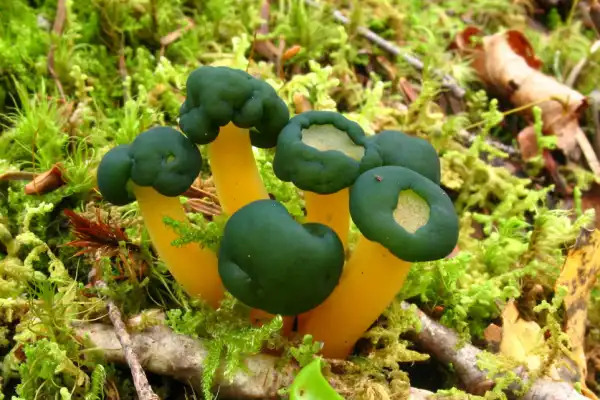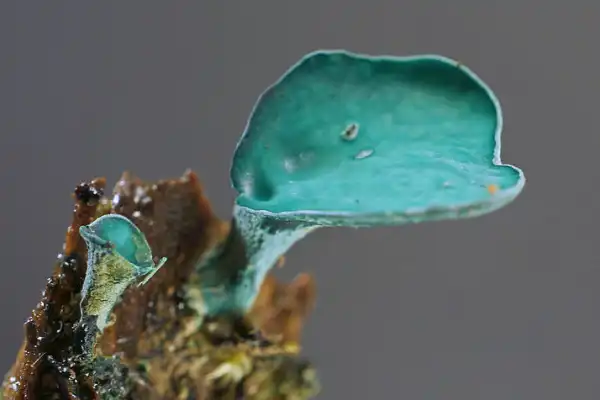The earth has adorable beauty, which can’t be denied by anyone. You might see green trees, algae, bushes, and herbs, but have you ever seen a green mushroom? Yes, a green mushroom. If not, then you can join our journey of exploration of green mushrooms. Here we go.
10 Green Mushrooms in the World You Need to See:
Mostly, whenever we think about mushrooms, we often imagine a red mushroom with a white stem and a red cap with some yellow and white spots. But have you ever encountered green mushrooms? If not, then here are some interesting facts about green mushrooms for you to consider.
1. Chicken Lips

- Botanical name: Leotia viscosa
- Identification: green cap with yellow stem
- Geographical range: California
This unique mushroom is most popularly named Chicken Lips and has the scientific name Leotia viscosa. You can find this species of green mushroom in California woodlands. The reason we call it unique is because of its coloration and cap shape.
Furthermore, its stem color ranges from yellow to white, and its cap is green. The mushrooms have a dark green cap, which can turn into a dark emerald in later growth stages. They have a bright yellow stripe and a wavy stripe.
The shape of its cap is not similar; it can grow in an indefinite shape. Also, this green mushroom is primarily found west of the Rocky Mountains.
2. Green Russula Mushroom
- Botanical name: Russula virescens
- Identification: Dome-shaped cap
- Geographical range: Spain and China
Russula virescens is a basidiomycete mushroom, also known as the green-cracking russula, quilted green russula, or green brittlegill. It has a pale green cap, crowded white gills, and a firm white stipe.
It is considered one of the best edible mushrooms of the genus Russula and is popular in Spain and China. Further, the cap is dome-shaped, convex, and flattened with age. The cuticle is green, with patches ranging from gray to verdigris to grass-green.
Other than that, the cap has a thin, thin cap cuticle and can be easily peeled off. Moreover, the gills are white to cream-colored and interconnected at their bases.
The stipe is cylindrical, white, and can turn slightly brown with age or handling. The flesh is brittle due to sphaerocyst cytoarchitecture.
3. Green Wood Cup

- Botanical name: Chlorociboria aeruginascens
- Identification: cup-like shape
- Geographical range: Europe, Asia, North America, South America, and Australia
Chlorociboria aeruginascens is a saprobic mushroom; you might know it by the name of green elfcup or green wood cup. As its name suggests, this species of green mushroom is easily identifiable because of its cup-like shape.
Other than that, the mushroom is small and has green fruit bodies. Further, the stem of the mushroom is typically less than 3 mm long and has spindle-shaped, smooth spores.
4. Verdigris Waxcap

- Botanical name: Gliophorus viridis
- Identification: Dark stripes across the cap
- Geographical range: New Zealand
coming to the next, Verdigris waxcaps are a type of green mushroom with dark stripes across the cap and a uniformly bright green nuance. They grow up to 1.5 inches tall and are named after their shiny, waxy texture.
These mushrooms are not edible and are characterized by their green to malachite green caps, which fade with age. They grow to 50mm tall and have a 20mm cap. Their spores are white.
5. Mouse-Pee Pinkgill

- Botanical name: Entoloma incanum
- Identification: Convex shape with a depression at the center
- Geographical range: Britain and Ireland
You might find this name ironic because it is actually green, except when it turns older. This plant is a saprobic herb that grows in unimproved grassland and woodland glades, mainly on alkaline soils. Its cap is 1 to 4cm across, initially conical or hemispherical, and later becomes broadly convex.
The yellowish flesh is thin and fragile, turning blue-green when bruised. The gills are distant, whitish, or tinged green, maturing greyish-pink, and turning blue-green when bruised. They plant fruits in summer and autumn in Britain and Ireland.
6. Parrot Mushroom
- Botanical name: Gliophorus psittacinus
- Identification: Gills are greenish with yellow edges
- Geographical range: Northern Europe
Gliophorus psittacinus, also known as the parrot toadstool or parrot waxcap, is a colorful mushroom found in Northern Europe. The small mushroom has a convex to umbonate cap up to 4 cm in diameter, which is green when young and yellowish or pinkish-tinged later.
Its stipe measures 2–8 cm in length and 3-5 mm in width. The broad adnate gills are greenish with yellow edges, and the spores are white. The spores are white, elliptical, smooth, and inamyloid. The odor and taste are mild, and it fruits from late summer to autumn.
7. Gliophorus graminicolor
- Botanical name: Gliophorus graminicolor
- Identification: Green body with white patches at the margin of the cap
- Geographical range: New Zealand and Australia
Gliophorus graminicolor is a green agaric fungus that grows saprobic on soil, mosses, leaf litter, or rotten wood in lowland Nothofagus and broadleaved conifer forests. It can grow up to 45 mm tall and 20 mm wide, with young specimens having a glutinous cap.
Mature specimens develop white patches around the cap margins and have an unpleasant burnt-hair odor. Gliophorus graminicolor grows in broadleaf forests and has a changing pattern of green colors.
An initial darker green nuance is specific to both the cap and stipe, with darker green stripes decorating the cap. The cap eventually becomes almost white with a central, round green spot.
8. Green Skinhead Mushrooms
- Botanical name: Cortinarius austrovenetus
- Identification: Thin web-like veil
- Geographical range: New South Wales, South Australia, and eastern Australia
Cortinarius austrovenetus, also known as Dermocybe austroveneta or green skin-head, is a brightly colored, inedible fungus found in south-eastern Australia. Its fruit bodies are smooth with a convex or flat cap, up to 16 cm across, and have yellowy brown, adnate gills underneath.
The mushroom has a thin web-like veil (cortina) protecting its gills during early growth, with remnants visible on the mature stipe.
9. Green Stem Pinkgill mushrooms

- Botanical name: Entoloma rodwayi
- Identification: Conical or Convex cap is yellowish green
- Geographical range: Tasmania
Entoloma rodwayi, also known as the green-stem pinkgill, is a yellowish-green mushroom found in Tasmania’s wet forests. It has a conical or convex cap up to 3 cm in diameter and can transform from yellow-green to vivid blue-green when dried.
The mushroom’s pink gills and spores are visible in the deposit and microscopically. The spores are pink when viewed in deposit and angular when viewed microscopically.
10. Lime-Green Waxy Cap
- Botanical name: Hygrocybe virescens
- Identification: Gills are whitish with lime green tones near the cap
- Geographical range: California, Washington, and Mexico
Hygrocybe virescens, also known as the lime-green waxy cap, is an agaric mushroom in the Hygrophoraceae family with limited geographical distribution. Its cap is 2 to 4.5 cm in diameter, conical or convex when young, but flat in maturity.
The cap color can be variable, from yellow to lime green. The cap surface is smooth and moist, but not sticky, and the margin becomes rimose with age.
The gills are whitish with lime green tones near the cap, and the stipe is 3 to 6 cm long and 0.3 to 0.8 cm thick. The stem is hollow and tapers slightly towards the top. The spores are ellipsoid, smooth, and inamyloid, with dimensions of 7–10 by 5–6 µm.
Conclusion:
These are some of the green mushrooms that, in reality, exist in nature. This species of fungus is really common all over the world, and the coloration of them totally depends on the atmospheric results and the weather in which it grows.
They are mostly seen on the oaks, woods, mud, and in wet areas. as they need water to grow. Like other fungi, some of the mushrooms are so poisonous that they can paralyze humans upon consumption. If you want to know more about mushrooms, then stay connected with HowItSee.
Reference:
- Wikipedia
- https://www.citscihub.nz/Phil_Bendle_Collection:Gliophorus_viridis_(Verdigris_Waxcap)#:~:text=viridis%20is%20most%20easily%20distinguished,or%20turn%20orange%20with%20age.
- https://www.citscihub.nz/Phil_Bendle_Collection:Gliophorus_graminicolor
Also Read:

As a content writer, I like to write about different niches. I have a curiosity about nature and animals. And like to learn about them. Through my writing, I like to share my experience and knowledge with you. I hope you are enjoying it too.
